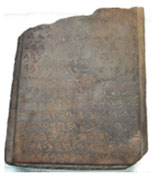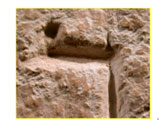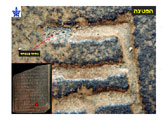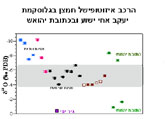Final Report Of The Examining Committees For the Yehoash Inscription and James Ossuary
Uzi Dahari
To: Shuka Dorfman, Director-General - Israel Antiquities Authority

The Committees Establishment and Selection of Members
Word of the almost simultaneously discovery of the bone box known as the “James Ossuary” and the Yehoash inscription, from an unknown source (not from an methodical excavation), together with the emotions raised by the finds and extensive public interest amongst Jews and Christians, obliged the Israel Antiquities Authority (IAA), the body responsible for all archaeological activities in Israel, to take action, to examine the finds and formulate a position on the subject. The IAA agreed to a short exhibit of the ossuary in Canada.
Numerous articles, all appearing within a short period of time, either confirm or deny the authenticity of the items. If the pieces are authentic (particularly the Yehoash inscription), then they are of great scientific value. The IAA was thus bound to do everything possible to arrive at the truth and present its conclusions.
After consulting with senior IAA advisors, IAA Director-General, Mr. Shuka Dorfman resolved to make every possible effort to examine the genuineness of the two finds. He then consulted scholars from various disciplines at the IAA and others, and set up two expert committees to examine the items from a scientific aspect and reach a conclusion regarding their authenticity. One committee was designated as the Writing and Content Committee and would use its knowledge of epigraphy and paleography to investigate whether the material content and language used are compatible with the Hebrew and Aramaic of the designated period. The second committee, the Materials and Patina Committee was to examine the substance of the materials, composition of the patina, additional materials present and perform any and every possible examination, including a morphological study of the items.
The Writing and Content Committee was comprised of two subcommittees – whose members were authorities on the First Temple period – archaeologists, linguists, historians, paleographers, epigraphers who would study the Yehoash inscription. The second subcommittee, consisting of archaeologists, Second Temple period linguistics scholars, who would study the ossuary. The Writing and Content Committee would, if needed, consult with Prof. Y. Naveh, an authority on ancient Hebrew writing of international repute, and with Dr. L.Y. Rahmani, an authority on ossuaries who had collected and published a vast amount of information on the subject.
The Materials Committee consisted of a geologist expert appointed by Dr. Amos Bein, Director of the Geological Survey of Israel, and who guaranteed his institute’s backing and scientific assistance (in spite of the conclusion reached earlier by two of the Geological Survey’s geologists), a petrograph expert, C14 researcher, and antiquities conservators with experience in ancient patina.
A great deal of attention was devoted to the choice of committee members. One consideration was the degree of involvement of each scholar in earlier research on the two items. Director-General Dorfman decided on a mix of committee members. The most suitable experts were chosen even if they had, in the past, expressed an opinion on the subject, as well as top scholars who had never been involved with the authenticity question.
The committee members were given specific guidelines: to arrive at the truth based on pure research only – without taking into account any other related factors regarding the collector, current gossip, rumors, or prejudices. Each scholar would work in his own discipline. The Writing and Content Committee members would each work alone during the early stages would later meet jointly. The Materials Committee members together photographed and took samples of the material so that the exact location and size of the sample would be precisely documented.
At the opening committee meeting, each member was given a file containing most of the published research and professional material gleaned from the internet, plus a large amount of information from the collector.
Following are the names and institutional affiliations of the committee members
The Writing Committee
Dr. Gideon Avni – Director of the Excavations and Survey Department, Israel Antiquities Authority, Committee Chairman.
Prof. Shmuel Ahituv – Ben Gurion University – Expert on Ancient Hebrew inscriptions.
Dr. Tal Ilan – Bar Ilan University – Historian, expert on the Hebrew and Aramaic names in the Second Temple period.
Dr. Esther Eshel – Bar Ilan University – expert on the history and development of Hebrew script.
Prof. Avigdor Horowitz – Ben Gurion University – world renown expert on ancient middle eastern languages.
Dr. Hagai Misgav – Hebrew University – expert on ancient Hebrew script and inscriptions.
Prof. Amos Kloner – Bar Ilan University – archaeologist, expert on burials and burial customs during Second Temple period Jerusalem.
Prof. Roni Reich – Haifa University – archaeologist, expert on First and Second Temple periods.
The Materials Committee
Dr. Uzi Dahari – Deputy Director, Israel Antiquities Authority, Committee Chairman.
Prof. Yuval Goren – Tel Aviv University – archaeologist and expert on petrography and identification of materials and sources.
Dr. Avner Ayalon – Geological Survey of Israel – geologist, expert on identification of materials through the study of isotopes in rock.
Dr. Elisabetta Boaretto – Weizmann Institute of Science – C14 expert.
Ms. Orna Cohen – expert conservator, specialization in identification and restoration of ancient patina.
Mr. Jacques Neguer – Israel Antiquities Authority – expert on antiquities conservation and restoration.
Each committee member received an official appointment from the IAA Director General (Appendix 1) .
Dr. Avner Ayalon received an additional appointment from Dr. Amos Bein, Director of the Geological Survey of Israel, as the authority for the instruments to be used in the examinations and based on his experience in geochemical applications and petrography identification and classification of materials (Appendix 2).
All the committee members participated on a completely voluntary basis.
The Committees Work

At the first meeting of the two committees, on Wednesday, 26 March, 2003, Mr. Dorfman presented the members with their aims - “to determine the authenticity of the two items. These determinations will be of dramatic significance both from an ideological and financial aspect” (Appendix 3 – minutes of the meeting). The committee chairmen then met with their members, formulated work rules and a time schedule (Appendix 4 – letter sent by Dr .Avni to the Writing Committee); Appendix 5 – protocol from materials committee’s first meeting, setting forth directions for research).
A room in the IAA offices was specially prepared to house the two items. Extremely powerful lighting, ultra-violet light, an illuminated magnifying lens, microscope and binoculars were provided. The room was available to committee members at any time. They received digital close-ups of the two inscriptions. Members of the Materials Committee naturally visited more than the others, take samples and close-ups. Moreover, the members sampled patina from other ossuaries and inscriptions in the IAA storerooms for comparison.
Each committee member was given up to three months to submit a final report summarizing his/her opinion and reasons for their conclusions.
The Materials Committee met for two additional meetings to exchange ideas and discuss research directions.
Three committee members were asked to prepare, in addition to their written report, a visual presentation for the Minister of Education, the IAA Director-General and the other committee members. Jacques Neguer prepared a visual presentation of the objects morphology; Yuval Goren a presentation of the petrographic composition of the materials and patina; Avner Ayalon a presentation of his geological research.
The research was conducted at the regular work place of each member, and on his/her own time.
Abstracts of Findings: Writing Committee – The Yehoash Inscription
Prof. Shmuel Ahituv (Appendix 6A)
The inscription was written by a speaker of modern Hebrew who borrowed segments from the original sources, composed a text that seemed biblical to him/her but failed. Therefore, the text is a forgery.
Prof. Avigdor Horowitz (Apprendix 6B)
The Yehoash inscription appears to be a combination of elements collected from various sources and pasted together … each element attests to a lack of understanding of ninth century BCE Hebrew. All the elements together clearly prove that the text is a forgery.
Dr. Hagai Misgav (Appendix 6C)
From the paleographic aspect, it appears that the inscription was written by someone not living in the First Temple times, but who wrote according to samples from that period. In other words, the inscription does not appear authentic.
Prof. Roni Reich (Appendix 6D and 6D1
It appeared to me at first that the inscription was authentic, as I wrote in my report. For one reason, it was difficult for me to believe that a forger (or group of forgers) could be found that would be expert in all aspects of the inscription… and could produce such an object. But I was convinced, in the end, that it is a forgery after being shown the committee’s data and material.
The Ossuary Inscription Committee

Prof. Amos Kloner (Appendix 6E)
It is clear that the engraving on the bone box dates from a different period than its original installation. The inscription appears new. The writer tried giving the letters an ancient appearance by using samples from contemporaneous inscriptions.
Dr. Tal Ilan (Appendix 6F)
Even if the ossuary is authentic, there is no reason to assume that the deceased was actually the brother of Jesus. But I am of the opinion that the inscription is a forgery.
Prof. Roni Reich (Appendix 6D and 6D1
The inscription does not exhibit a combination of configurational or substantial effects that would imply forgery. But I was convinced that the inscription is a forgery when presented with the findings by the Materials Committee.
Dr. Esther Eshel (Appendix 6G)
From my examination of the inscription and the data I received, it appears to me quite clear that the inscription is not authentic, and was added at a much later date (possible in two stages).
The Materials Committee

Jacques Neguer (Appendix 6I)
The ossuary is authentic. Its inscription is a forgery. All the various scratches on the ossuary are coated in the original patina and only the inscription and its immediate surroundings are coated with an artificial “patina’-like material of round crystalline granules. The inscription cuts through the original patina and appears to have been written by two different writers using different tools.
Orna Cohen
Ossuary: The first part of the inscription is new, cuts through the original patina and is coated with a granular patina that appears to have been produced from chalk dust mixed with water and spread on the inscription. The end of the inscription “brother of Jesus” appears authentic, in some places there seems to be remains of old patina, but in order to produce a uniform effect, this too was spread with the same granular substance.
Inscription: The “patina” on the inscription side was dissolved in water and therefore looks like earth rather than patina. When the letters were cleaned, the manner of inscription was exposed. The technique appears new and does not match the original wear on the stone. The manner in which the letters were scratched does not resemble any form of ancient stone inscription.
In summary, both inscriptions are false.
Prof. Yoval Goren (Appendix 6J)
Ossuary: The ossuary itself is authentic based on the accumulation of patina and varnish (varnish = patina from a biological source).
The inscription was inscribed or cleaned in a modern period. Its coating is not a result of nature, and was probably accomplished by crumbling and dissolving chalk (or perhaps the powder falling from the engraving process) in hot water and spilling the suspension on the inscription and surrounding area in order to blur the freshly carved inscription.
Inscription: The stone is greywake, an exotic stone for Israel, originating in north Syria or western Cyprus.
The original silicate patina exists on the reverse side of the tablet. hard and firmly attached to the stone. The engraved letters did not appear to have undergone any corrosive process as would be expected from an ancient inscription.
The inscription coating has a different composition than that of the patina on the back of the stone, and appears to be an artificial mixture of clay, crumbled chalk, carbon, and microscopic granules of inert metal. It appears that this mixture was dissolved in hot water before being spread on the inscribed side, after which the stone was heated to a temperature of no higher than 4000C in order to harden the new coating and give it the appearance of patina.
Method: The “patinization” is similar in both cases but on the ossuary, chalk powder only was used, and on the Yehoash inscription a mixture of clay or red soil, chalk powder, carbon and metal granules.
Conclusions: The inscriptions on both items are forged and date to modern times.
Composition of Isotopes In Oxygen In The Ossuary and the Yehoash Inscription
Letters patina
Yehoash inscription
surface patina
sea chalk
Dr. Avner Ayalon (Appendix 6K)
Oxygen possesses three isotopes: oxygen 16, 17, 18. When atmospheric conditions (moisture and temperature) vary, the relationship between these isotopes changes, especially between oxygen 16 and 18 (the amount of oxygen 17 decreases greatly and is difficult to measure). I sampled the patina of the Yehoash inscription and the original patina in various places on the ossuary distant from the inscription and for comparison, took samples from the surface and inside the letters inscribed on other ossuaries. The result is clear: patina samples from the other ossuaries and from the James Ossuary away from the letters fall within the acceptable isotope range for patina accumulation in the Jerusalem area within the last three thousand years and patina samples from the letters of the James Ossuary and the patina of the Yehoash inscription letters fall out of this range, showing that the letters patina could not have formed within the Jerusalem area’s climatic conditions.
“Patina” of such an isotope composition was probably created from a mixture of materials and water heated to a temperature that does not exist in our area.
Therefore, I conclude that “patina” in the Yehoash the ossuary letters is forged (details of the stages of the Materials Committee’s work in the presentation in Appendix 10).

Dr. Elisabetta Boaretto (Appendis 6L)
The ossuary patina does not contain material that can be sampled for C14, and is thus irrelevant for dating by this method.
The inscription patina contains very small, but adequate quantities of carbonates that can be tested in an accelerator. Such a sample was taken by the Israel Museum and sent to Florida for examination. Due to the small quantity of material, carbon was collected from several places on the inscription stone so that the sample is not a representative one, but rather an average of the material sources. The resulting date received (after calibration) is 390 – 200 BCE. I didn’t collect any material for further analysis because I don’t believe such an analysis to be significant toward determining authenticity, for the following reasons: A) the test for dating the carbon is irrelevant since ancient carbon can be added to the falsified material; b. the objects, since their discovery, have passed through many different places without any documentation. Exposure of he objects to modern pollutants can affect results of dating analyses.
Based on the above, I conclude that no relevance can be placed on a date received from C14 dating of the Yehoash inscription authenticity.
Summary
On June 15, 2003, the committees met, first separately, and then jointly, in order to arrive at a collective conclusion. I presented the results of the Writing Committee to the Materials Committee and results of the Materials Committee to the Writing Committee.
The two committees then joined in the Director-General’s office. (Appendix 7 – Protocol of Concluding Session) where a discussion took place to which the collector, Mr. Oded Golan was invited (in response to the request of Mr. Golan’s lawyer) to present his argument and position on the matter of the two items. At the conclusion of his presentation, Mr .Golan was asked a number of questions by the committee members.
At the conclusion of deliberations, the committee members summarized the results of their research and wrote an abstract of their findings (Appendices 8 and 9), as follows: “We, members of the committee for examination of the content and script in the Yehoash inscription and the James Ossuary (James son of Joseph brother of Jesus” conclude that to the best of our scientific judgement:
A) the Yehoash inscription is a forgery
B) The James Ossuary inscription is a forgery
We, the committee members for examination of the materials of the Yehoash inscription and the James Ossuary conclude that the patina on both items is forged and significantly varies from the original patina on the items.
Respectfully,
Dr. Uzi Dahari
Deputy Director and
Chairman of the Materials Committee and
Committees Coordinator